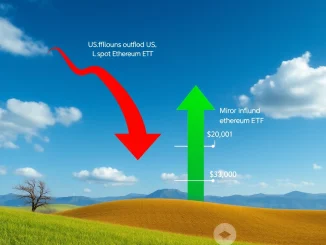
Imagine sending money across African borders without the hefty fees and delays often associated with traditional methods. That’s the promise being explored as **USDC**, the popular dollar-pegged stablecoin, takes center stage in a new pilot program.
**Circle** and Onafriq Team Up for Cheaper Payments
In a significant move for digital currency adoption, **Circle**, the technology firm behind the **USDC** stablecoin, has joined forces with Onafriq, a major African payments company. This partnership isn’t just theoretical; they’ve launched a pilot program designed to significantly reduce the cost of **cross-border payments** across more than 40 countries in Africa.
Onafriq operates an extensive network across the continent, connecting over 500 mobile money wallets and reaching over 200 million bank accounts. By integrating **USDC** settlements into this vast network, the pilot aims to bypass traditional, often expensive, remittance channels.
Addressing the High Cost of **Cross-Border Payments** in **Africa**
Africa faces some of the highest average costs for sending and receiving money internationally. These fees can eat into the value of remittances, which are a critical source of income for many families. The World Bank has long highlighted the need to reduce these costs, particularly for intra-African transfers.
Using a stablecoin like **USDC**, which is designed to maintain a stable value relative to the US dollar, offers a potential solution. Transactions settled on a blockchain network can often be faster and cheaper than those processed through correspondent banking systems.
How the **USDC** Pilot Works
The core idea is simple: leverage Onafriq’s existing mobile money and banking infrastructure with the efficiency of **USDC** on a blockchain. While specific technical details of the pilot are still emerging, the general flow likely involves:
- Users on one side initiate a payment via Onafriq’s network.
- The value is potentially converted into **USDC** for the cross-border transfer phase.
- The **USDC** is settled efficiently between Circle and Onafriq systems.
- On the receiving end, the **USDC** is converted back into local currency or credited to a mobile money wallet or bank account via Onafriq’s network.
This process aims to cut out layers of intermediaries, thereby reducing fees and potentially speeding up settlement times.
Potential Benefits for **Africa**
The success of this pilot could bring several advantages:
- **Lower Costs:** The primary goal is to make sending money cheaper, putting more money directly into the hands of recipients.
- **Increased Speed:** Blockchain settlements can potentially reduce the time it takes for funds to arrive.
- **Greater Accessibility:** Leveraging mobile money networks taps into a large, often unbanked or underbanked population.
- **Enhanced Transparency:** Blockchain transactions offer a degree of transparency not always present in traditional systems.
This initiative represents a tangible application of stablecoin technology addressing a real-world economic challenge in **Africa**.
What This Means for **Circle** and the Stablecoin Market
For **Circle**, this pilot is a significant step in expanding **USDC** utility beyond cryptocurrency trading and into mainstream financial services, particularly in emerging markets. It demonstrates the potential of **USDC** as a tool for efficient global value transfer.
The success of such pilots can build confidence in stablecoins for practical, everyday use cases, potentially paving the way for broader adoption across other regions facing similar remittance challenges.
Looking Ahead
The **Circle** and Onafriq pilot is a promising development in the evolution of **cross-border payments**. While it’s still early days, the potential to drastically cut costs and improve efficiency for millions of people across **Africa** is substantial. The results of this pilot will be closely watched as the financial world explores how digital currencies and blockchain technology can build more inclusive and affordable payment systems.
This collaboration highlights how established financial infrastructure can merge with innovative digital assets to create powerful new solutions.



